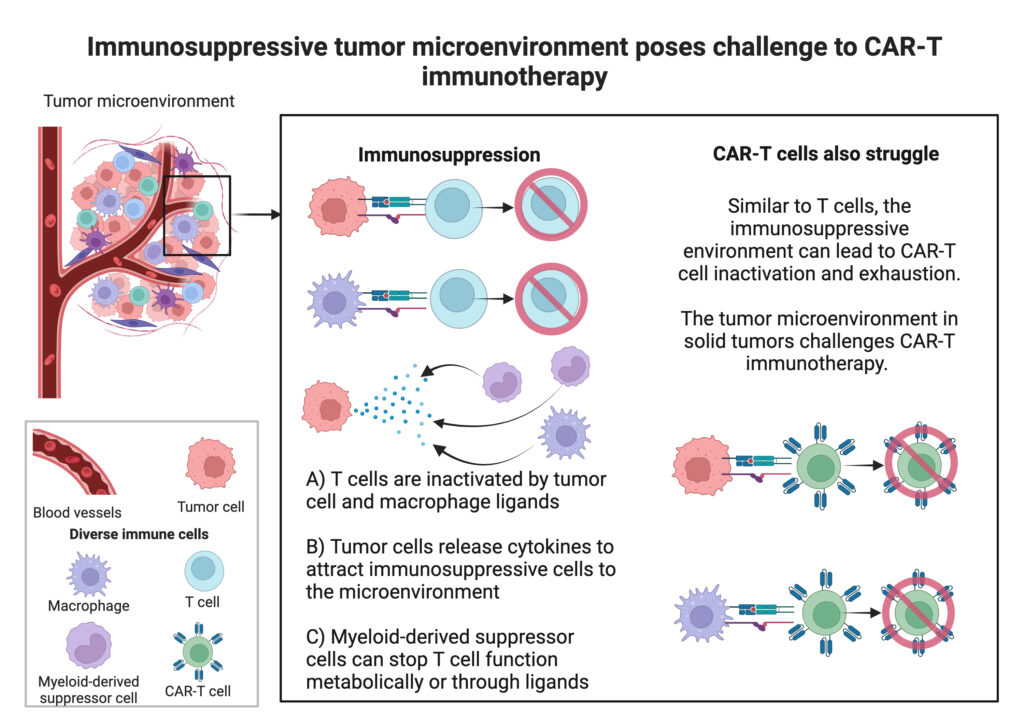What is CAR-T immunotherapy?
Since 2017, the Food and Drug Administration has approved six chimeric antigen receptor-T (CAR-T) therapies. The basic approach of CAR-T immunotherapy is to change a patient’s T cells by adding a gene that can recognize and kill cancer cells better than normal T cells. These CAR T cells are expanded and put back into the patient’s body. CAR-T is a cancer immunotherapy that has been considered a “breakthrough” in cancer treatment. Cancer immunotherapy boosts a person’s own immune system to fight against cancer. However, all six of these CAR-T therapies have been approved to treat blood cancers, such as lymphomas and leukemias. Unlike blood cancers, solid tumor cancers have a tumor microenvironment, and this is an obstacle for CAR-T immunotherapy treatments.
What is a tumor microenvironment and how does it help cancer progress?
The tumor microenvironment (TME) is an ecosystem surrounding the tumor. Some of the components that make up this TME are immune cells, blood vessels, and connective tissue. The tumor interacts and uses these parts to survive and to grow. For example, the blood vessels deliver necessary oxygen to the tumor.
One of the hallmarks of cancer is immune evasion, meaning that the tumor is able to avoid being destroyed by the immune system and “hijack” immune cells to help it grow. The immune system recognizes abnormal substances in the body and attempts to get rid of them. In cancer, immune cells called T cells go to the tumor site and try to kill the abnormally dividing cells.
However, in the TME, these cells are unable to function properly. But why? The TME creates an immunosuppressive environment that prevents T cells from doing their job. Immunosuppression is a dampening of the immune response. As represented in the figure, the TME is able to achieve the suppression of the cancer-fighting T cells by recruiting immunosuppressive immune cells, releasing immunosuppressive signals, and consuming nutrients that T cells need to fight the tumor. 
In conclusion, these immunosuppressive cells stop T cells from doing their job, thus, allowing the tumor to develop. There is a never-ending loop of T cells trying to get rid of the tumor and the tumor suppressing the T cells in order to keep growing.
How does the tumor microenvironment affect CAR-T immunotherapy?
The tumor microenvironment supports the immunosuppressive cells, and this leads to exhaustion and inactivation of the CAR-T cells. Immunosuppression by the solid tumor microenvironment is a crucial element that negatively affects the success of CAR-T immunotherapy.
How can CAR-T immunotherapy be improved to deal with the tumor microenvironment?
The combination therapy of CAR-T immunotherapy and an immune checkpoint inhibitor is able to alter the role of the immune system. Immune checkpoint inhibitors weaken the immunosuppressive immune cells, which gives T cells the ability to keep fighting the cancer. Overcoming the challenges of the tumor microenvironment has great potential in improving CAR-T immunotherapy in solid tumors.
Peer Editor: Caitlyn Molloy